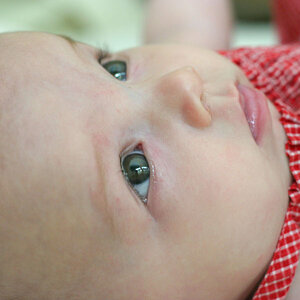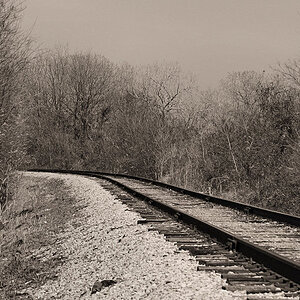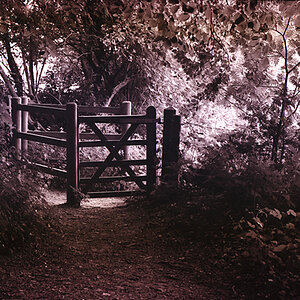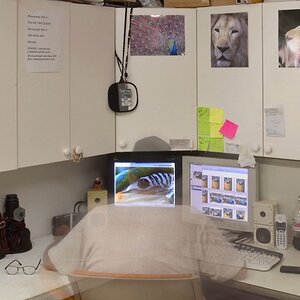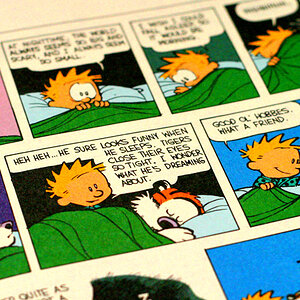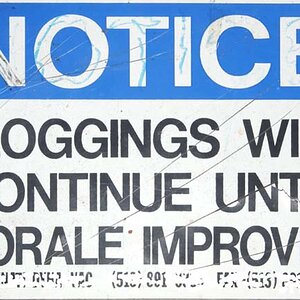Oneirophile
TPF Noob!
I'm guessing this is the right forum to ask this in, even though it's about a film project, the technical aspect should be identical. It's a bit of a weird problem, I give you that.
So I'm shooting this experimental film thing, more precisely, other people are shooting it for me in my haunted house attraction on Halloween (long story), using my camcorder in Night Shot Mode. It's a cheap Sony DCR-HC52 Camcorder, but it's otherwise perfect for the job. So there's an Infrared-Lamp on the camcorder and the cam - unlike the people - is capable of seeing the light it emits, hence the people have to use the camcorder in order to see and move around in an otherwise pitch black environment - that's what I want. Now comes my problem:
For some reason, the camcorder is absolutely incapable of "seeing" any trace of anything that has been printed, written, etc once it has to rely on the IR-Lamp as only light source. E.g. I have a white page with black text on it, the image the camcorder sees will be a blank sheet only, as if the ink just wasn't there (my printer is a Canon Pixma ip4000). The same thing even happens with hand-written stuff, using ball-pens, felt-pens, whatever - not a trace of the ink/paint is to be seen. The content of my developed photographs is also invisible to the cam and they are being recorded as blank sheets of photo-paper.
This is a huge problem because my project features lots of written notes, signs or maps, which all end up not being seen on camera. However, SOME printed things are perfectly visible, like the text on the cover of a bottle of paint I only recorded by accident. But that hasn't been printed by myself but the company who sells the paint, of course. So in the end, there have to be certain types of ink that are invisible in IR-light, and others that aren't. :scratch:
Surely, this isn't a problem related to the model of camcorder but to the IR-spectrum itself. Yet it puzzles me: How can a piece of paper that is partially covered in ink reflect light in the same way as a totally blank one? There really are no traces to be seen. So my question is:
How can I find out which types of ink are visible in IR-light and which ones aren't, and how can I print my notes so that they will end up being recorded?
PS: the pieces of paper aren't overly reflective or over-exposed. The ink becomes visible once an additional light source is added that isn't IR. I'll post a picture soon, my PC is busy rendering a video right now ...
So I'm shooting this experimental film thing, more precisely, other people are shooting it for me in my haunted house attraction on Halloween (long story), using my camcorder in Night Shot Mode. It's a cheap Sony DCR-HC52 Camcorder, but it's otherwise perfect for the job. So there's an Infrared-Lamp on the camcorder and the cam - unlike the people - is capable of seeing the light it emits, hence the people have to use the camcorder in order to see and move around in an otherwise pitch black environment - that's what I want. Now comes my problem:
For some reason, the camcorder is absolutely incapable of "seeing" any trace of anything that has been printed, written, etc once it has to rely on the IR-Lamp as only light source. E.g. I have a white page with black text on it, the image the camcorder sees will be a blank sheet only, as if the ink just wasn't there (my printer is a Canon Pixma ip4000). The same thing even happens with hand-written stuff, using ball-pens, felt-pens, whatever - not a trace of the ink/paint is to be seen. The content of my developed photographs is also invisible to the cam and they are being recorded as blank sheets of photo-paper.
This is a huge problem because my project features lots of written notes, signs or maps, which all end up not being seen on camera. However, SOME printed things are perfectly visible, like the text on the cover of a bottle of paint I only recorded by accident. But that hasn't been printed by myself but the company who sells the paint, of course. So in the end, there have to be certain types of ink that are invisible in IR-light, and others that aren't. :scratch:
Surely, this isn't a problem related to the model of camcorder but to the IR-spectrum itself. Yet it puzzles me: How can a piece of paper that is partially covered in ink reflect light in the same way as a totally blank one? There really are no traces to be seen. So my question is:
How can I find out which types of ink are visible in IR-light and which ones aren't, and how can I print my notes so that they will end up being recorded?
PS: the pieces of paper aren't overly reflective or over-exposed. The ink becomes visible once an additional light source is added that isn't IR. I'll post a picture soon, my PC is busy rendering a video right now ...


